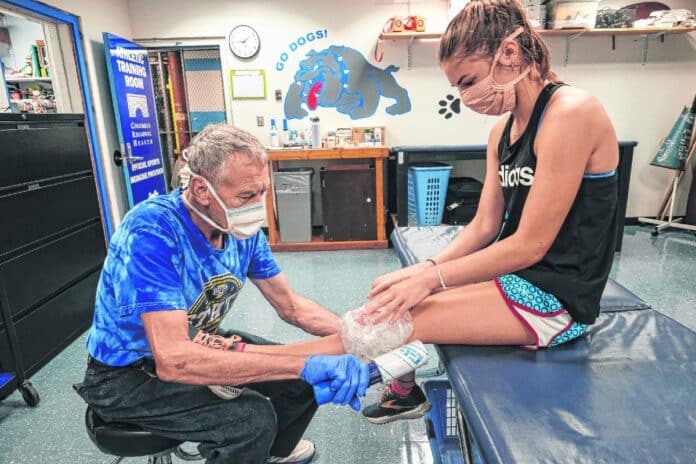
Hands washed and sanitized? Check.
Mask? Check.
Gloves? Check.
The list of daily precautions has grown for Columbus North athletic trainer Ashley Martin over the past few months, but not just because of her job requirements. Martin, 29, is a high-risk individual for catching COVID-19.
[sc:text-divider text-divider-title=”Story continues below gallery” ]Click here to purchase photos from this gallery
That’s because Martin suffers from Crohn’s disease, which is an autoimmune disorder.
When Martin was a freshman at Shelbyville High School, she first started feeling the effects of her autoimmune disorder, and by the time she was a junior, she was diagnosed with Crohn’s disease. She was initially prescribed with Remicade.
“I was actually really relieved to find out what was wrong because it took two years of different tests, blood work, and doing a colonoscopy a couple times to finally figure out what was really going on,” Martin said. “I was just happy of having a diagnosis and being able to start taking medicine to make me feel better. It was kind of rough because I missed a lot of school, but overall, I just learned how to cope with it.”
Martin was on Remicade until last November when the medication stopped working because her body was building antibodies to the drug. She was then prescribed with Stelara, and she has been on that medication since.
Martin said she takes the shot every eight weeks, but added that she is switching it to every seven weeks. The medications “shut off” her immune system — making her more susceptible to the virus.
It can be worrisome for Martin at times, but she said she has learned to deal with it and take all the precautions necessary for her to stay as safe as possible.
“I do have that cross my mind, but I know that I’m doing everything I can to prevent it,” Martin said. “I’m making sure that athletes are also being safe and following everything. I think as long as we continue to do that, I feel pretty safe being here.”
Martin, who has been an athletic trainer at North since October 2016, said that many of the students know about her condition, and she also takes similar precautions during the cold and flu season.
“I really don’t feel that unsafe being here,” Martin said. “I’m a little nervous about when the kids go back to school, but when we get there, we get there. It won’t be that bad.”
When the coronavirus pandemic started in March, it was an adjustment for Martin. She admits that she hasn’t been to a grocery store or any other store except to get her medications. She would receive her groceries and other essentials from fellow North athletic trainer Steve Souder and his wife Ardis, or from one of her bosses.
Martin said she also socially distanced herself from others, and didn’t feel comfortable seeing her parents or other members of her family for a good month-and-a-half.
“I have a community around here that has offered to get me anything I kind of needed or anything like that,” Martin said. “I’m just really fortunate and blessed that I do have people in this community that will help when needed, so that’s nice.”
Adjusting to a new normal
Martin isn’t the only local athletic trainer taking extra precautions this fall.
Columbus East athletic trainer McKensie Vanosdol is close with her family, which includes her parents, grandparents, a niece and a nephew, and said she is more worried about being a carrier of the virus than actually getting it.
“I know that it is a scary virus, and everything about it is unknown and uncertain,” she said. “I like to think that I’m healthy enough that I can fight it off and turn out OK because I’m still fairly young, but I’m afraid for others around me.”
Vanosdol said she follows guidelines whenever she goes out in public to not only keep her safe, but others safe.
“I wear my mask. I keep my distance from people when I go into the store,” Vanosdol said. “I’m not one to linger around in a store anyway and nosy around. I’m in and out, and I don’t hang about, but wash your hands, keep yourself clean and keep stuff sanitized.”
Souder, 65, who has been an athletic trainer at North for 42 years, is high-risk because of his age. He said his weekly and daily routines have changed, including going out to dinner with his wife each week.
Following protocol
As important as it is to keep themselves healthy, the athletic trainers have a job to do to keep the athletes and everyone else around them safe.
At Hauser, the doors are propped open so athletes can enter and exit the facilities without having contact. Disinfectant wipes are used during and after the workout session on all the balls and equipment that was used. The indoor courts used for basketball and volleyball are sanitized following practice.
If a Hauser athlete has to use the restroom facilities, they either go to the south gym lobby for indoor workouts or use the press box for outdoor workouts.
While East and North each have two athletic trainers on staff, Amy Shipp is a solo act at Hauser.
Shipp said the athletes are restricted to only one water bottle and a change of shoes. Tape is marked 6 feet apart where they can lay their personal belongings down. She also said the kids are responsible for filling their water bottles, but they have to sanitize their hands before they do so.
With Shipp working alone, and more than one sports workout going on at the same time, it can get hard to police all the time with the lack of manpower.
Shipp said it is up to the athletes to be responsible and follow the guidelines not only for themselves, but for others, as well.
“At some point with anything, people have to start taking accountability for themselves,” Shipp said. “We put the information out there, give them every means necessary to keep them safe, so we just have to hope on the honor system at some point. We feel like we are meeting everything and providing our community with a safe environment.”
When it comes to water for the football and soccer teams, East athletic trainer Michaela Dilling says there’s a hydration station set up since the athletes don’t have access to water as easy as indoor sports do.
The players will bring their water bottle up to the station, but keep their lid, and hand the bottle to Dilling. Dilling, who is wearing gloves, will then take the bottle back to the hose to fill it up. Afterward, the table is sanitized, the gloves are thrown away, the hose is sanitized, everything is wiped down and hands are washed.
It seems like a long process, but Dilling said there haven’t been a ton of issues.
“We’re pretty well planned out. We never really had an influx of kids all at once needing their water,” Dilling said. “The table that we have out there, there’s two ends, so one kid can be on one end, and another kid on the other still six feet apart.”
There also are restrictions on the number of athletes that can be in the athletic training room. Over at East and North, three to four athletes are allowed in the trainer’s room at a time. When seeing the trainers for any injury they need treatment on, an appointment would have to be scheduled.
As a safety precaution, all athletes in the training room wear masks. The trainers also wear masks and gloves for their protection.
East recently expanded to a larger training room over the summer that will be used this coming year.
“For the most part, our kids are pretty much spread out, so we haven’t had an issue,” Vanosdol said. “We can at least, for sure, do three-at-a-time and space them out every other table and keep everyone safe and distanced.”
With Hauser having a smaller facility, only one athlete is allowed to enter at a time. The school is also cutting down on congestion by holding practices to two two-hour sessions per week.
“For the summer workouts so far, it hasn’t been to where that they needed extensive care as of this point,” Shipp said. “We have them spaced out pretty well to where we’re not having a mass of kids go at the same time, so that helps us out in all capacities.”
Prepared for a positive case
All the athletic trainers said the Indiana Department of Education has guidelines in place and that they are prepared in the event of a COVID-19 case popping up.
“I feel like that kind of goes with the entire world and our job in general,” Dilling said. “I mean, there is always that little bit of preparedness that you have to have for any kind, whether it simply be an illness or an injury, you’re always in the back of your mind thinking through that process and trying to prepare and how you’ll respond and react to it if it were to happen.”
Monday, Phase 2 of the IDOE’s three-phase approach to return to athletics began. If a case does occur, trainers said it could be more challenging to determine the contact tracing because contact is allowed.
“It’s a bit easier in Phase 1. When they’re supposed to be in smaller cohorts, you can eliminate the cohorts that person was in,” Martin said. “But in Phase 2, they can have contact, they can have cross-sectioning, and that’s when things could get more murkier.”
So far, the three Bartholomew County public schools haven’t had a known case of COVID-19, but officials realize that could change at the drop of a hat. A few high school teams in Indiana had players and coaches test positive for the virus last week.
“That would be the worst case, but so far, we’ve been lucky,” Souder said. “That’s why we keep telling the kids to stay distanced and to wear their masks.”
If there is any chance for a football season, or any fall sports season to happen, all administrators, coaches and players are being held accountable for their actions and follow all the rules and guidelines to keep everyone safe.
“I think everyone has that lingering suspicion about it and a little bit of fear because there’s so much unknown with it,” Dilling said. “But I know that we’re taking all the precautions we can and doing all the stuff we can to try our best to keep every single person safe and prevent anything from happening.”




